While there are three types of scallops, only two are widely consumed in the United States -- bay and sea scallops. Both of these types are generally sold out of the shell and cleaned. This means that only the adductor muscle -- the ivory-colored, meaty portion -- of the scallop is cooked and eaten. The main difference between bay and sea scallops is size, which affects how they are cooked.
Cooking Methods
Scallops take well to both dry- and moist-heat cooking methods, and their delicate, sweet flesh lends itself to either high- or low-temperature cooking methods. This means that the right cooking method for scallops depends largely on the size of the scallops and how they are being served.
Scallop Size
Larger scallops, sea scallops, are well-suited for any type of cooking method, while smaller scallops, bay scallops, are better suited for cooking methods that do not require cooking the scallops individually. For example, bay scallops take well to poaching, baking or sautéing, while sea scallops can be poached, baked or sautéed, but they are also well-suited for grilling or pan-searing.
Texture
High-heat cooking methods, such as pan-searing or broiling, are used to produce a sear on scallops. The high temperature browns the flesh and gives the soft meat added texture, by crisping the exterior. The meatiness of sea scallops holds up well to this treatment, while bay scallops can easily have their natural flavor overwhelmed with this type of treatment.
Moist heat cooking methods preserve the natural velvety texture of the seafood and keep the meat moist and sweet. As a gentler cooking method, both sea and bay scallops benefit from this cooking method.
Seasoning Scallops
Scallops can be seasoned before, during or after cooking. The porous flesh means that scallops absorb flavors with minimal time. The delicate sweetness of the scallop can be easily overwhelmed however, so do not let scallops marinate for an extended period -- no more than 30 minutes. After marinating, cook the scallops as you would plain, un-marinated scallops.
Seasoning ideas include:
- Crushed chili flakes, garlic, sesame seed oil and minced ginger
- Rosemary and lemon zest
- Mustard powder, cayenne pepper, dried thyme and minced green onions
- White wine vinegar, fresh tarragon and minced shallot
Cooking Scallops
Bay Scallops
Poach or steam bay scallops, or, if necessary, quickly sauté them. Prolonged cooking times can lead to overcooked, tough, chewy bay scallops that have lost their natural sweetness and juiciness.
To poach bay scallops:
Combine 1 cup of fish stock, 1 cup of white wine, 1 smashed clove of garlic and a sprig of fresh thyme in a wide-bottomed sauce pan. Bring the mix to boil on high heat, then add a 1/2 to 1 pound of bay scallops.
Stir the scallops, then turn off the heat and cover the pan, letting the scallops sit for 3 to 7 minutes. More scallops will require a longer resting time. Remove the scallops from the liquid with a slotted spoon.
Reduce the poaching liquid by half and add 2 tablespoons of butter and 1 teaspoon of lemon juice. Season with salt and pepper and pour the sauce over the scallops.
Sea Scallops
Sea scallops are meaty enough to withstand the textural changes that occur due to pan-searing, broiling or grilling. The larger size also means the scallop is at less risk of being overwhelmed with other seasonings.
To pan-sear sea scallops:
Pat dry the sea scallops with a paper towel; patting them dry helps them brown better.
Heat a stainless steel or cast-iron skillet on high heat. Add 1 to 2 tablespoons of butter and 1 tablespoon of olive oil, and reduce the heat to medium-high. Add 1 teaspoon of minced garlic, 2 teaspoons of orange zest and 1 1/2 teaspoons of fresh rosemary to the melted butter.
Place the scallops, flat side down, in the hot, seasoned butter and oil. Sear for 3 to 5 minutes, undisturbed, to brown the bottom of the scallop. Flip the scallops using tongs, sprinkle the scallops with salt, and cover, lowering the heat to low. Cook for another 2 to 5 minutes, then remove the pan from the heat and let rest for 5 minutes.
Testing for Doneness
Scallops are fully done when their internal temperature reads 125 to 130 degrees Fahrenheit. However, the scallops will continue cooking after they are removed from the heat. To prevent overcooking, remove the scallops when their internal temperature reads 115 degrees F, and let them rest for 2 to 5 minutes before serving.
Testing the internal temperature with a quick read thermometer is not always practical, especially with bay scallops. In these cases, signs of doneness include a gentle firming of the scallop. The flesh will also turn opaque and white.
Related Articles
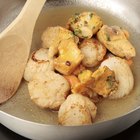
How to Cook Scallops in Butter
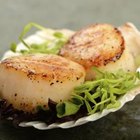
The Best Ways to Cook Scallops
How to Freeze Sea Scallops

How to Grill Bay Scallops
How to Cook a Bass Fillet

How to Cook Bream Fish
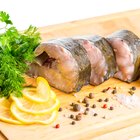
How to Cook Sturgeon Fillets
How to Cook Atlantic Salmon Fillets

How to Pan-Sear Swordfish
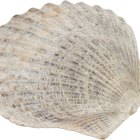
How to Bake Scallops in the Shell

Difference Between Boiled & Grilled ...
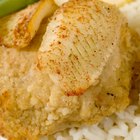
How to Cook Stuffed Tilapia

Cooking Scallops in a George Foreman

How to Clean Scallops
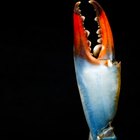
How to Cook Blue Crab
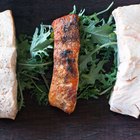
How to Cook Sea Trout

How to Cook Parrotfish

How to Steam Lobster & Shrimp
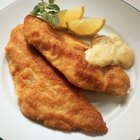
How to Fry Fish in Butter

How to Cook Eelpout
References
Writer Bio
Cynthia Au has studied at the Cordon Bleu in Paris and currently works as a chef instructor specializing in food styling. She has worked as a writer and editor with a focus on food and food science since 2007 and regularly teaches both adults and young children about the joys of home cooking.